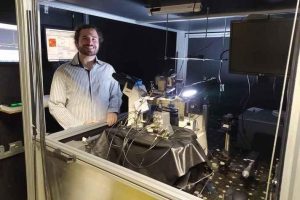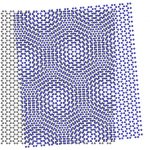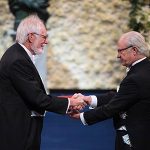#accessibility The image shows the hexagonal structure of the graphene layers.
Text written by our collaborator Caroline Santos
Paradoxical as it may sound, the “nano” world (one billionth of a meter) has been growing! Nanoscience and nanotechnology are taking shape and appearing in the most varied fields, but beyond doubts one of the greatest representatives of this group is the graphene!
Officially discovered by a group of researchers from the University of Manchester in 2004 (details of this discovery were published here on the blog), the material was known decades ago, but only as a theory to explain the allotropic forms of carbon. It was only in 2004, isolating a sheet of graphene, that we started to know its properties.
Graphene is composed of a two-dimensional (2D) carbon layer organized in hexagonal structures, forming one of the most resistant materials found in nature presenting a high thermical and eletrical conductivity than other materials and a surface area greater than graphite. But the outstanding property lies in its superconductivity.
It was only in 2018, that researchers at the Massachusetts Institute of Technology (MIT) discovered the graphene superconducting behavior by, precisely, rotating its layers by 1,1°. But so far, such behavior has not been explained yet.

So, done with the presentations, let’s move to today’s protagonist: the nanoscope.
The equipment in question was developed by a group of scientists from the Federal University of Minas Gerais (UFMG) in Brazil and it lit up details of the graphene structure, in particular, its vibrational and electrical behavior, in a nanometric scale, like no other equipment was capable of.
As explained by the project coordinator and professor at UFMG Ado Jorio, when rotating a graphene layer, in degrees below 1°, it is possible to observe an instability in its structure, which tends to return to its equilibrium state and form triangular regions, that can be seen through the nanoscope. Once these regions are connected to the properties of the material itself, it may point the way to the understanding of its superconducting behavior.
This layers “twist” system is part of the so-called twistronics. In simple terms, twistronics is the study of the rotation, in precise degrees, of two-dimensional (2D) layers of ultrafine materials in order to identify and manipulate the properties of matter and establish new physical phenomena.
And that’s where the nanoscope takes its place! With the use of a nanoantenna, the equipment can produce an image, in nanometric scale, that allows the observation of crystallographic structures in a way that no other optical equipment is capable of, allowing more detailed analysis of the samples.
At the article published by the scientific journal Nature, the nanoscope was used for the atomic, vibrational and electronic study of graphene layers, but as stated by researcher Ado Jorio, the equipment has the potential to be used to understand different structures and has great potential for application the engineering of superconducting nanomaterials in the most different fields, as it allows the observation and manipulation of material properties in a way never seen before, or as the researcher illustrates: “Changing from the microscope to the nanoscope is like changing from the naked eye to the microscope, a resolution gain of a thousand times”.
After 15 years, and as a result of interdisciplinary work by UFMG research groups, the commercial prototype of the nanoscope has been developed and has, to date, nine patents including Brazil, China, Europe and the United States, enabling its application in the industry in the near future.
Sources:
Featured image: Image from seagul by Pixabay
Image 1: Andreij Gadelha, UFMG collection
<https://exame.com/ciencia/nanoscopio-brasileiro-para-estudo-do-grafeno-e-nova-capa-da-nature-veja/>
<https://www.sbpmat.org.br/pt/tag/grafeno/>
<https://periodicos.set.edu.br/exatas/article/download/2778/1617/>
Learn more:
Video COLLOQUIUM DIEI – NANOSCÓPIO: DA RECONSTRUÇÃO EM BICAMADAS DE GRAFENO À INOVAÇÃO (02/10/2020) from channel IFSC USP on YouTube


